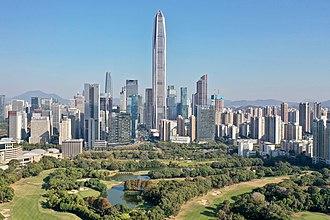Unraveling the Complexities of Shenzhen’s Urban Growth: A Novel Model for Sustainable City Development
Shenzhen stands as a striking example of China’s rapid urban expansion, evolving from a modest fishing village into a cutting-edge technological center in just a few decades. This swift transformation brings with it the pressing challenge of harmonizing robust economic advancement with environmental stewardship. At the heart of this challenge lies the need to manage intensified land use while simultaneously addressing carbon emissions and preserving ecological balance. A pioneering study featured in Frontiers introduces an integrated analytical framework—PLUS-InVEST-PLES—that offers urban planners an advanced toolkit to navigate these multifaceted trade-offs. This model not only refines decision-making but also fosters resilient, sustainable urban ecosystems. As cities globally confront similar dilemmas, Shenzhen’s approach provides valuable lessons on aligning growth ambitions with ecological preservation.
Balancing Urban Expansion and Environmental Health in Shenzhen
The rapid pace at which Shenzhen is expanding presents both opportunities for prosperity and risks to its natural environment. The intensification of land use often leads to habitat loss, increased greenhouse gas emissions, and diminished ecosystem services—factors that threaten long-term sustainability. Recent data indicates that China’s urban areas contribute nearly 60% of national CO₂ emissions, underscoring the urgency for effective management strategies in megacities like Shenzhen.
To tackle these challenges comprehensively, researchers have combined three powerful tools—PLUS (Patch-generating Land Use Simulation), InVEST (Integrated Valuation of Ecosystem Services and Tradeoffs), and PLES (Potential Land Ecosystem Services)—into one cohesive framework. This synergy enables detailed spatial analysis that captures how different land use scenarios impact carbon storage capacities and biodiversity levels.
Key interventions derived from this approach include:
- Strategic Green Infrastructure: Designing interconnected green corridors within urban zones to enhance carbon absorption.
- Sustainable Building Practices: Promoting energy-efficient construction powered by renewable sources.
- Civic Participation: Engaging residents actively in planning processes to foster community-driven sustainability initiatives.
Quantifying interactions between carbon fluxes and ecosystem health involves several critical indicators:
| Indicator | Description | Significance |
|---|---|---|
| Carbon Sequestration Capacity | The ability of vegetation-rich areas within the cityscape to capture atmospheric CO₂. | A vital component for mitigating climate change effects locally. |
| Biodiversity Richness Index | A measure reflecting species diversity across various habitats inside urban boundaries. | An indicator signaling ecosystem resilience against environmental stressors. |
| Land Utilization Efficiency | The effectiveness with which available land supports development without compromising natural functions. | A foundation for sustainable spatial planning policies. |
By embedding these metrics into planning workflows, Shenzhen can adeptly balance its developmental goals alongside conserving vital ecological assets.
Leveraging Integrated Frameworks for Resilient Urban Development
As Shenzhen accelerates toward becoming a global smart city leader, maintaining equilibrium between infrastructure growth and nature conservation becomes paramount. The PLUS-InVEST-PLES methodology serves as an innovative blueprint by synthesizing scientific modeling with participatory governance tools.
This comprehensive system evaluates multiple ecosystem services concurrently while identifying priority zones where sustainable development can flourish without degrading environmental quality.
Core focus areas include:
- Ecosystem Carbon Storage Potential: Pinpointing green spaces capable of maximizing CO₂ uptake efficiently;
- Biodiversity Conservation Mapping: Protecting critical wildlife habitats amid expanding built environments;
- Sustainable Land Allocation: Optimizing space usage through vertical building designs or mixed-use developments that reduce sprawl impacts;
Recent assessments using this framework reveal promising figures within Shenzhen’s metropolitan area:
| Ecosystem Indicator | Status/Value | Description/Impact | ||||||
|---|---|---|---|---|---|---|---|---|
| Total Carbon Stored (million tonnes) | 3 million | % Ecological Zones vs Total Area | 27% | Total Urban Green Space (hectares) | 5,500 ha |
These insights empower policymakers to prioritize investments where they yield maximum environmental returns alongside social benefits.
Strategies To Embed PLUS-InVEST-PLES Into Future City Planning
Maximizing the potential offered by this integrated framework requires deliberate actions centered on collaboration among government agencies, private sector partners, academia, and local communities.
Recommended approaches encompass:
- Evidenced-Based Scenario Modeling: Utilize predictive analytics driven by real-time data streams forecasting outcomes under varying development plans;
- Catalyzing Public-Private Synergies: Forge partnerships combining technical expertise with financial resources aimed at green infrastructure projects;
- Sustainable Land Stewardship Policies: Implement zoning regulations encouraging compact growth patterns while safeguarding ecologically sensitive sites;
- Civic Empowerment Programs: Support grassroots initiatives promoting awareness about conservation practices tailored specifically for rapidly growing neighborhoods;
Continuous monitoring frameworks are essential components ensuring adaptive management capabilities remain responsive over time:
| Monitoring Element | Recommended Action |
|---|---|
| Dynamic Data Updates | Incorporate satellite imagery & IoT sensor networks providing near-real-time feedback on land cover changes |
Conclusion: Synthesizing Growth With Sustainability in Shenzhen—and Beyond
As one of China’s fastest-growing cities continues its trajectory toward global prominence, mastering the interplay between economic expansion and ecological preservation remains crucial.
The PLUS-InVEST-PLES integrated model equips decision-makers with nuanced insights into how various facets such as carbon fluxes , biodiversity health ,and efficient land utilization intersect during rapid urbanization . By applying such comprehensive analyses ,Shenzhen exemplifies how modern metropolises can pursue ambitious development agendas without sacrificing their natural heritage .
This paradigm holds significant promise not only within China but also across other fast-developing regions worldwide facing similar pressures . Cities like Bangalore , Lagos ,and São Paulo could adapt comparable frameworks tailored locally —demonstrating that accelerated modernization need not come at nature ’s expense . Ultimately ,the choices made today will shape tomorrow ’s livable cities —making innovative approaches like PLUS-InVEST-PLES indispensable tools guiding sustainable futures .
